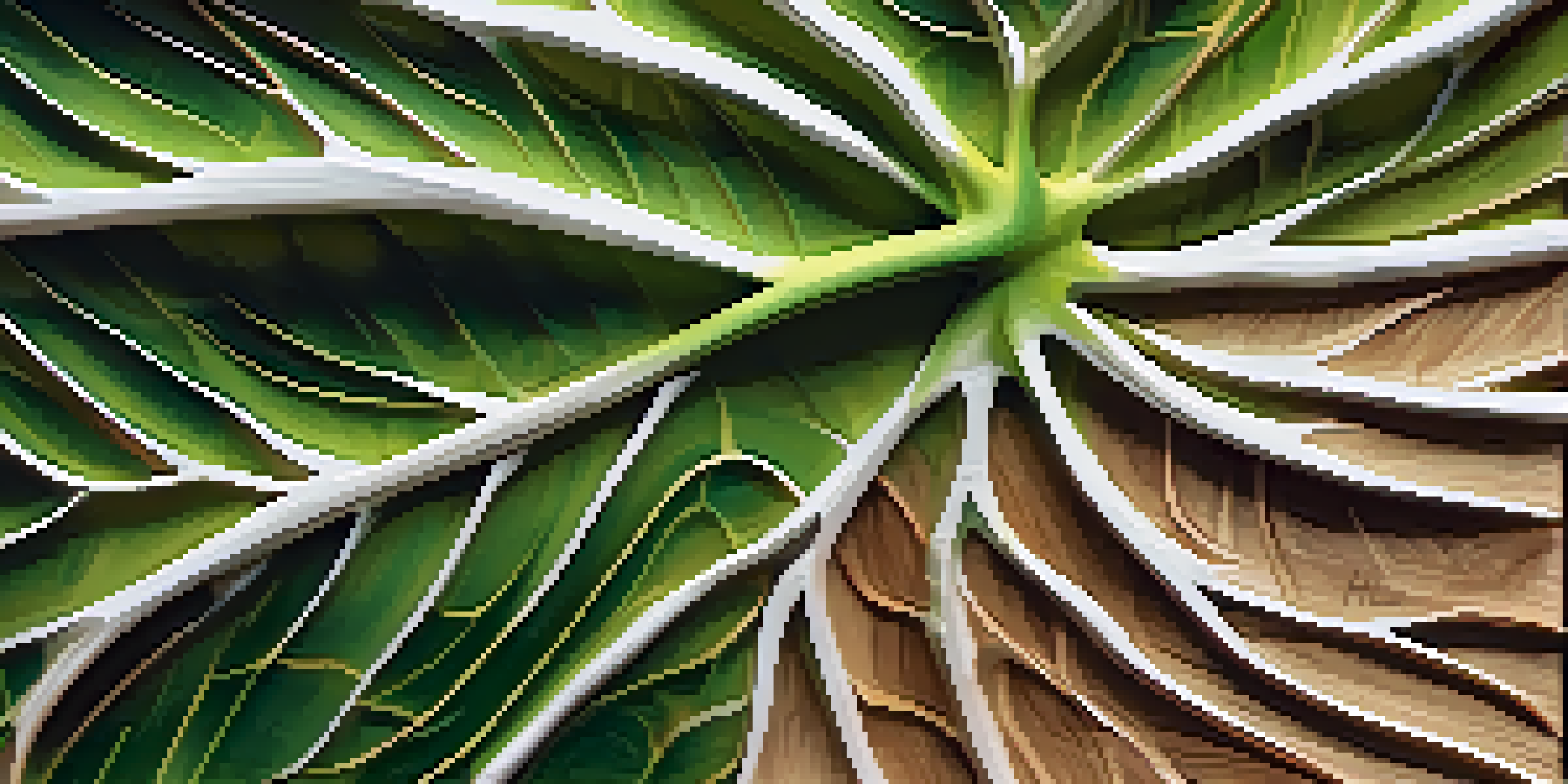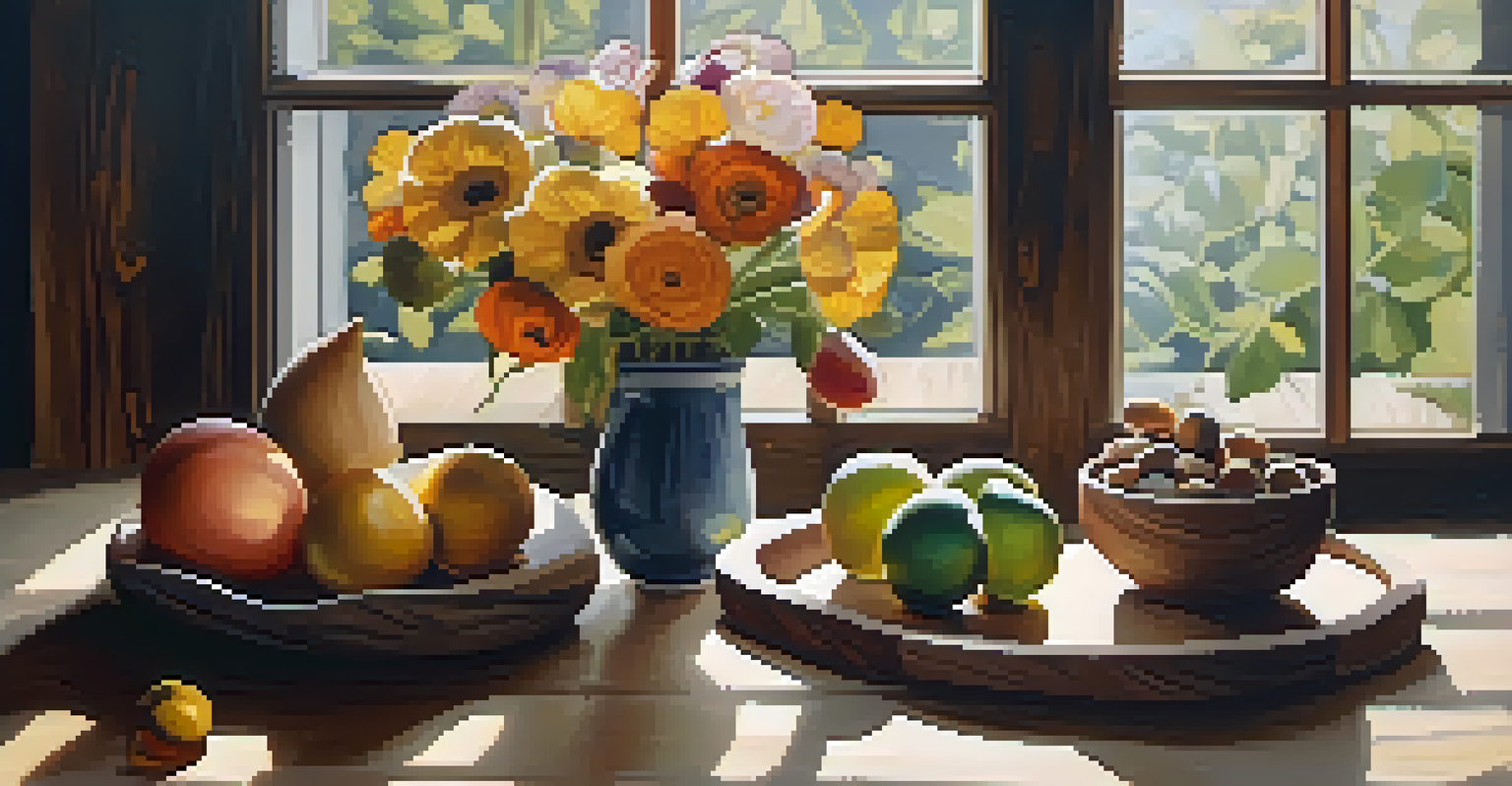Organic Shapes: Carving Techniques Inspired by Plant Life

The Beauty of Organic Shapes in Art and Design
Organic shapes are often inspired by the natural world, particularly plant life. Unlike geometric shapes, which are rigid and predictable, organic forms are fluid, asymmetrical, and full of character. This inherent beauty makes them a popular choice among artists and designers alike, as they can evoke feelings of tranquility and connection to nature.
Nature does not hurry, yet everything is accomplished.
Incorporating these shapes into your work can bring a sense of warmth and authenticity. Think about the soft curves of a leaf or the intricate patterns of a flower; these elements can add depth and interest to your projects. By studying the natural world, artists can learn to appreciate the subtleties that make organic shapes so appealing.
Moreover, organic shapes often resonate on a deeper emotional level. They remind us of the beauty that exists in nature, encouraging a sense of harmony and balance in our designs. This emotional connection is what makes organic shapes not just aesthetically pleasing, but also meaningful.
Understanding Carving Techniques for Organic Forms
Carving techniques can vary widely, but the goal remains the same: to create forms that celebrate the essence of nature. Traditional methods, such as whittling or chip carving, allow artisans to manipulate materials like wood or stone into flowing shapes reminiscent of plants. Each technique brings its own unique qualities, helping to achieve different textures and finishes.

For instance, using a gouge can create smooth, rounded edges, while a chisel can add sharper details to mimic the jagged lines found in leaves. Experimenting with these tools can lead to unexpected results, just like the diverse forms found in nature. Embracing this trial-and-error approach is crucial for developing your skills.
Organic Shapes Evoke Nature's Beauty
Incorporating organic shapes into art fosters a sense of warmth and emotional connection to the natural world.
Additionally, it's important to visualize the final piece before you start carving. Consider how the light will play on the organic shapes and how they will interact with their surroundings. This foresight can guide your carving process and enhance the overall impact of your work.
Finding Inspiration in Flora: A Practical Approach
Inspiration can be found all around us, especially in the world of plants. Taking a walk through a garden or forest can spark ideas for your next carving project. Pay attention to the shapes, colors, and textures that catch your eye; these observations can serve as a foundation for your designs.
The beauty of nature is that it is always changing, and so is the art that reflects it.
One effective method is to take photographs of plants and create a mood board. This visual reference can help you identify common themes and shapes that resonate with you. Consider creating sketches based on these images to explore different interpretations of organic forms.
Remember, nature is the ultimate teacher. The more you observe and engage with your surroundings, the more ideas you will generate. This practice not only enhances your artistic vision but also deepens your appreciation for the intricate beauty of plant life.
Materials for Carving Organic Shapes: Choosing Wisely
Selecting the right material is vital when carving organic shapes. Common choices include wood, stone, and even synthetic materials, each offering unique properties that can influence the final outcome. Wood, for instance, is favored for its warmth and workability, while stone provides durability and a sense of permanence.
Consider the characteristics of each material: softer woods are easier to carve, while harder woods offer more intricate detailing. Experimenting with different materials can help you discover what suits your style and the specific forms you wish to create. It's all about finding the right balance that complements your artistic vision.
Carving Techniques Enhance Design
Using various carving techniques and materials allows artists to create organic forms that reflect the intricacies of nature.
Additionally, don't overlook the importance of finish. The final treatment of your carving can enhance its organic qualities. Natural oils or waxes can enrich the color and texture, while varnishes can provide a sleek, modern look. Think about how the finish will interact with the organic shapes and contribute to the overall aesthetic.
Techniques for Achieving Natural Textures in Carving
Creating realistic textures is key to making your organic shapes come alive. Techniques such as stippling or burnishing can add dimension and depth, mimicking the intricate details found in nature. For example, using a wood burner to create fine lines can replicate the veining seen in leaves, adding authenticity to your work.
Experimenting with various tools can also lead to unique textures. For instance, a wire brush can create a rough, weathered look, while finer tools can produce smooth surfaces. The choice of tool significantly affects the tactile quality of the final piece, so don’t hesitate to explore different options.
Ultimately, the goal is to evoke a sense of realism and connection to nature. By focusing on texture, you can enhance the organic shapes you've carved and invite viewers to appreciate the beauty of the natural world through your art.
Embracing Imperfection: The Beauty of Organic Forms
One of the most appealing aspects of organic shapes is their inherent imperfections. Unlike geometric forms, which are often symmetrical and uniform, organic shapes celebrate asymmetry and irregularity. This can be seen in everything from the gnarled branches of a tree to the unpredictable curves of a flower petal.
Embracing these imperfections can lead to more authentic and relatable art. It allows the viewer to connect with the piece on a personal level, as they see the beauty in the flaws. This perspective encourages artists to let go of the pursuit of perfection and instead focus on the essence of their work.
Embrace Imperfection in Art
Celebrating imperfections in organic shapes leads to more authentic art that resonates with viewers on a personal level.
In carving, this means allowing the natural characteristics of the material to shine through. Rather than forcing a shape to conform to a specific idea, let it evolve organically. This approach not only enhances creativity but also results in pieces that truly embody the spirit of nature.
Final Thoughts on Carving Techniques and Organic Shapes
Carving organic shapes inspired by plant life is a fulfilling and enriching practice. It allows artists to connect deeply with nature while exploring their creativity. By utilizing various techniques and materials, you can create pieces that resonate not only visually but also emotionally.
Remember, the journey of carving is just as important as the final product. Embrace experimentation, learn from your mistakes, and find joy in the process. Every carve, every stroke, contributes to your growth as an artist and your understanding of organic forms.

As you continue to explore this art form, keep an open mind and heart. Let the beauty of nature guide your hands and inspire your creations. The world of organic shapes is vast and full of possibilities, waiting for you to carve your own path.